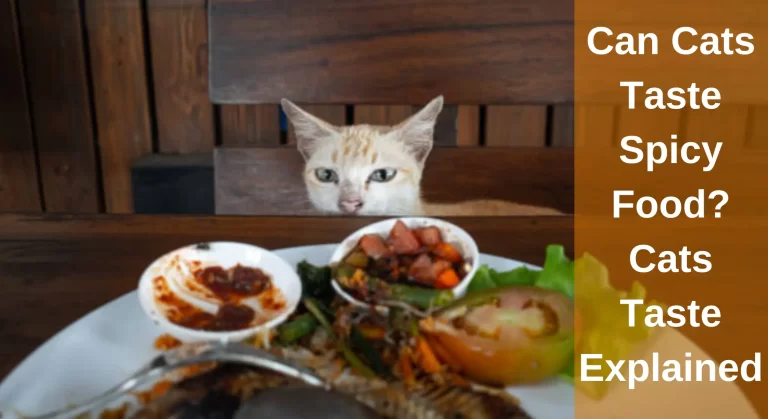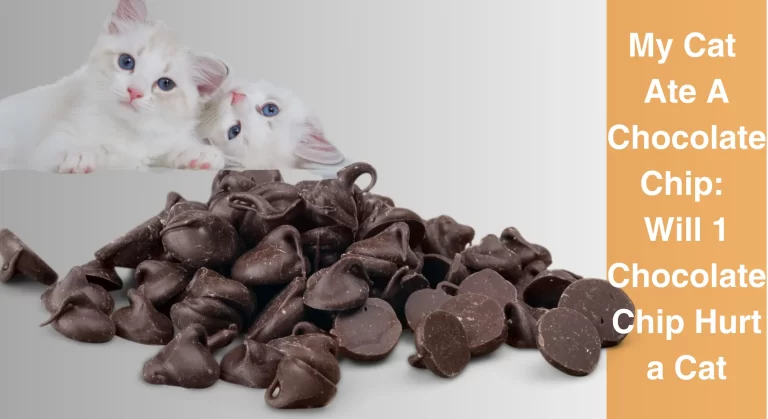Can Cats Eat Vanilla? Everything You Need to Know Before Feeding Your Furry Friend
The most common flavor you may find in a seasoning rack is vanilla. Vanilla has undeniably left its imprint on the culinary arts as a popular choice for sweets, aromas, and foods. But as a loving cat owner, you might be curious about if vanilla is safe to consume despite the fact that it is a delicious and pleasant ingredient for us. “Can Cats Eat Vanilla?”
Technically Yes, cats can eat vanilla in small amounts. However, it is not recommended to feed vanilla or any other human food to cats as part of their regular diet. Vanilla extract and other vanilla products should be used sparingly, as they are high in sugar and may contain other ingredients that are not safe or healthy for cats.
You might become confused now about how much vanilla you should give and what are the symptoms of vanilla toxicity. Don’t fret; in this post, we’ll explain how much vanilla you can give your cats, what type of vanilla is safe for them, whether can they eat vanilla ice cream or pudding, and much more!
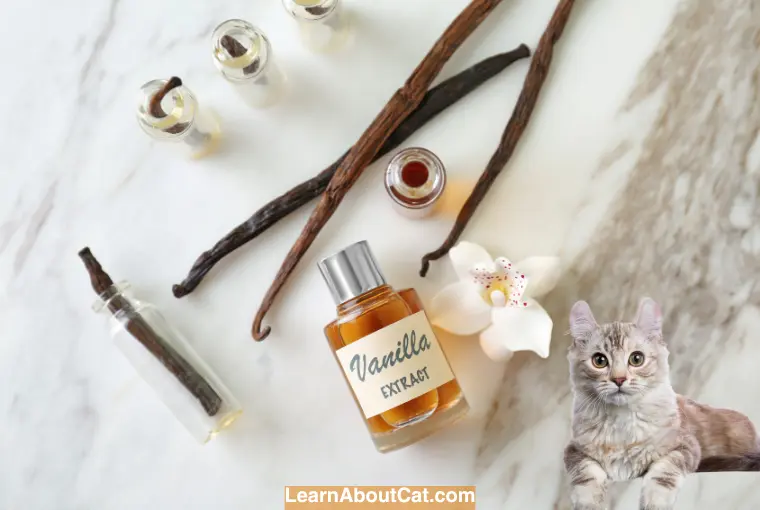
Can Cats Taste Vanilla?
Yes, cats have taste receptors on their tongues and are capable of tasting vanilla. However, cats’ sense of taste is different from ours; therefore, they probably experience flavors differently.
We may not, though, completely understand how well our cats can know the taste of these items. They have fewer taste buds than humans and are not able to taste sweetness as well as we can. In fact, they are more sensitive to sour and bitter flavors and tend to prefer foods that are rich in protein and fat.
Cats might not be particularly interested in sugary diets and prefer dishes with intense meats or fishy flavors. So, it’s still not clear whether cats taste vanilla the same as we do.
Check Out: Can Cats Eat String Cheese?
Is It Okay to Give Cats Vanilla Ice Cream?
Vanilla ice cream is the best popular means of introducing vanilla to cats. But they shouldn’t always eat it. Ice cream is full of elements that aren’t good for cats’ stomachs or nutrition, yet a small bite might not hurt them.
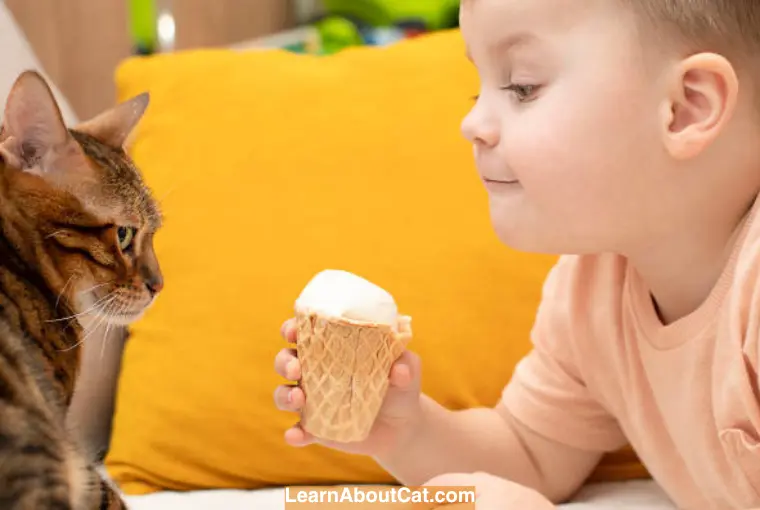
Furthermore, since most ice cream contains a lot of sugar, we don’t advise giving it to the most cat. Sugar merely provides refined sugar. Neither vitamins nor minerals are given to your cat by it. Also, if they consume excessive amounts of it, they might put on weight.
Moreover, if cats are given the option, some of them will probably pick ice cream over cat chow due to the fatty content of ice cream, which might cause nutritional issues.
Second, ice cream contains a lot of dairy products. Most cats are allergic to lactose. Hence, they may feel nauseous. Naturally, each cat has a different threshold for dairy sensitivity. Due to their great sensitivity, some cats who eat ice cream might experience severe diarrhea.
If they don’t consume much food, others might be all right. Dairy is typically inappropriate for cats once they reach maturity, regardless of the situation.
Thirdly, a lot of ice creams have additional ingredients. They might be okay for your cat, but they might not. For example, certain sugar substitutes might be harmful to cats. It is essential to check the ingredient label to confirm that vanilla ice cream contains no poisonous substances.
Also, Check Out: Can Cats Have Whipped Cream?
Is Vanilla Toxic to Pets?
Most cats can safely consume vanilla without alcohol. There are numerous extracts available that are alcohol-free.
Nonetheless, many vanilla essences are produced using alcohol. It is not acceptable for your feline to ingest in these circumstances. Alcohol can poison cats in even trace doses. As a result, it’s not recommended. In particular, if they consume the entire bottle, it may result in major health issues.
For this purpose, we advise carefully reviewing the vanilla essence components before taking any further action. These products’ labels do not clearly distinguish one from the other. Yet, the list of ingredients needs to be precise.
Find Out: Can Cats Eat Cake? [Answered]
What Type of Vanilla is Toxic to Cats?
As you know, vanilla extract by itself offers zero nutritional advantages. Also, some forms of vanilla that are described below are extremely toxic for cats:
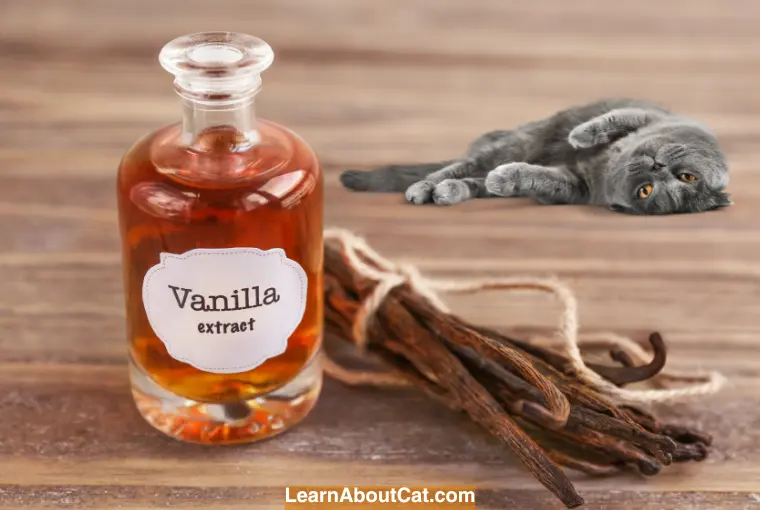
Vanilla Oils
Much like most essential oils, vanillas are very powerful. This implies that the plant’s power is concentrated in bottles and converted to a pure state. Because of how deadly this is, it is essential to always keep all pure oil away from your cats.
Vanilla Mists and Perfumes
It’s possible that vanilla mists and perfumes are more harmful than pure vanilla. They include poisons and substances that can seriously damage your cat’s neurological and gastrointestinal systems.
The majority of these flavors, though, won’t be appealing to your cat, who might naturally turn them down.
Vanilla Essence
A maximum of 34% alcohol can be found in vanilla extract. If your cat consumes a sufficient amount, it could have seriously detrimental consequences on its health.
Symptoms + Importance of Keeping Vanilla Away from Cats
If cats consume vanilla extract, you should look out for these signs of alcohol poisoning:
- Autonomic dysfunction
- Lack of energy
- Puking
- Recumbency
- Spasms
- Hypertension
- Confusion
- Screaming
- Hypotension
- Breathing depression
- Coma
- Death
Take your cat immediately to the veterinarian as soon as these signs appear. The outcome relies on what cats ate, how much they ate, their age, and their physical well-being.
Although it’s not possible, there are still many chances that your cat may consume sufficient vanilla essence that will seriously harm it. Your cat will probably sniff it, consume it, and then leave, which will be the more common outcome.
Moreover, your cat may enjoy vanilla extract sometimes. So, ensure that all spices, sauces, and culinary items stay out of access to eliminate the possibility of poisoning.
If your cat eats anything pricey, it may require expensive veterinary appointments, which might be problematic if you weren’t planning for the expense.
Can I Give My Cat Vanilla Pudding?
Vanilla pudding contains vanilla essence but in low amounts, so it is usually fine for cats. Though if alcohol is used to make it, pudding and many other additives considerably dilute it. Hence, vanilla is usually not the element about which you should be concerned.
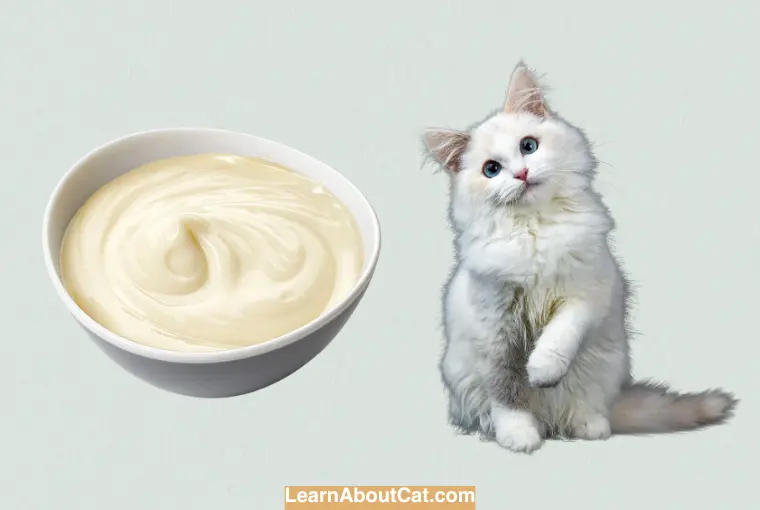
Although, it doesn’t mean your feline should consume the pudding. The additional sweetness in the pudding is frequently a poor nutritional option for cats. This can quickly lead your cat to eat more calories than necessary, which can cause weight gain. Pudding and ice cream share several similarities.
So, all the other ingredients are harmful to your cat, not just vanilla. Pudding that contains dairy is generally not a suitable choice for cats. Unfortunately, not all puddings are like this. Some are created without dairy products and are typically marked as such on their packaging.
Dairy is generally inappropriate for cats, and most adult cats are sensitive to dairy. Hence, pudding containing dairy might result in a variety of stomach issues. Although it is not poisonous, the majority of cats should not use it.
You Might Like to Find Out: Can Cats Drink Oat Milk?
How Much Vanilla is Safe for My Cat to Eat?
Your cat shouldn’t consume any vanilla essence. Alcohol intoxication can be brought on quickly with this small body.
However, if your cat sneaks a lick, watch out for signs and consult your veterinarian if your cat exhibits unusual behavior. Avoid the vanilla out of sight!
Is Artificial Vanilla Safe for My Cat?
Artificial vanilla, also known as vanillin, is generally considered safe for cats in small amounts. It is commonly used as a flavoring agent in cat food and treats, and is often added to medications to make them more palatable.
It also frequently uses flavorings produced from chemical-containing wood residues and has the same quantity of alcohol in them. There is nothing problematic for us, but a hypersensitive cat might experience many issues.
However, it is important to keep in mind that artificial vanilla products may contain other ingredients, such as sugar or alcohol, which can be harmful to cats if consumed in large quantities.
Guaiacol and phenol, or compounds produced from the refinement of oil, gasoline, and wood, are typically used to make artificial vanilla.
The unnatural ingredients might leave your cat unwell; however, for home chefs, it’s not a major concern since you’re preparing vanilla parfait, custard, or dessert that requires a genuine blast of vanilla.
Still, the pure vanilla essence is unlikely to captivate your cat, which is fortunate given the fact that it includes a significant amount of alcohol.
Can Cats Eat Vanilla in Food?
The biggest problem with vanilla-flavored meals (dessert, ice cream, etc.) isn’t the vanilla itself; rather, it’s the additional ingredients, particularly the sweetness and dairy. A cat consuming excess sugar is likelier to become overweight and become diabetic.
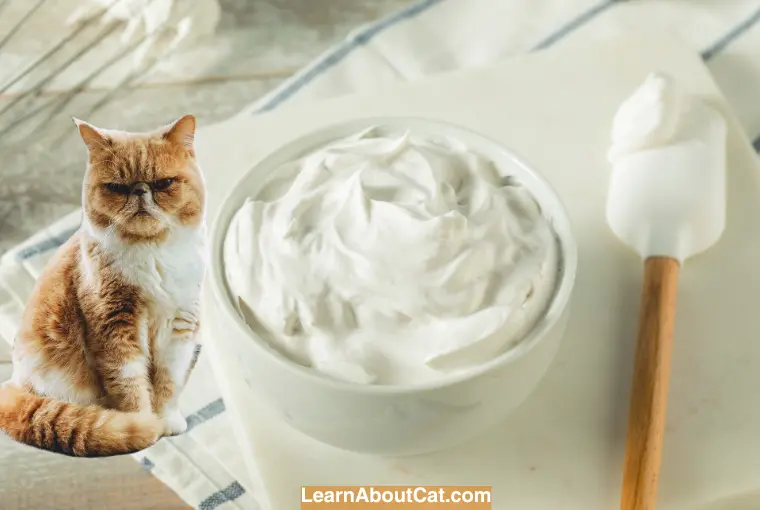
Similarly, most cats like vanilla yogurt. It has a pleasant flavor, is easier on the gut, and doesn’t contain any frills that bother cats.
Just make sure to choose yogurt that has as few additional ingredients as feasible, doesn’t contain sweeteners, and, if at all feasible, is lactose-free. Yet other vanilla cat diets typically include too much sweetness to be healthful, making it the most suitable for cats.
Frequently Asked Questions
Can vanilla kill my cat?
Pure vanilla extract is not toxic to cats in small amounts. However, ingesting large amounts of vanilla can cause gastrointestinal upset, such as vomiting and diarrhea. Additionally, some vanilla products may contain alcohol, which can be toxic to cats in high concentrations.
It is also important to note that not all vanilla products are created equal. Some vanilla-flavored foods and treats may contain other ingredients that are harmful or toxic to cats, such as chocolate or xylitol.
There’s also a chance that some cats have allergies to vanilla. Thus, it’s recommended to refrain from offering your cat vanilla.
Can cats eat vanilla cake?
Vanilla cake is safe for cats to consume, but they must do it in balance because excessive consumption could be detrimental. Only a tiny bit should be required.
You shouldn’t give your cat a full piece as she doesn’t require that much sweetness and energy. Carefully examine the cake’s components to ensure there is no ethyl alcohol, which might cause cat alcohol toxicity.
Does vanilla extract calm cats?
Yes, but only under very particular circumstances does vanilla extract relax cats. For example, if your cat went to the vet for a checkup or experiencing stress due to multiple cats in your home, you can place a little drop of the vanilla extract under your cat’s tail to make her relax.
Can cats eat vanilla yogurt?
Yes, cats can consume vanilla yogurt it is not recommended and it must not contain ethyl alcohol. Because it includes sugar, which is dangerous to cats, yogurt should only be provided occasionally.
You can occasionally use yogurt in your cat’s meals and nutritional supplements. But, since cats can’t properly absorb sugar, you should make sure the yogurt you give them is plain and unsweetened.
Final Verdict:
As soon as vanilla is not alcoholic, it is safe for cats. Alcoholic and non-alcoholic ingredients are both used in the production of vanilla essence. Read the ingredient labels carefully and only buy alcohol-free vanilla as a result. Even if there’s not much liquor in any vanilla, it could impact your kitten.
Moreover, many products, such as pudding or ice cream having vanilla flavoring, contain additional sugars, which are unhealthy for cats. Thus, before giving your cat anything, make sure to read the ingredient labels. That may not be the ideal option if it contains added sugars.
Also, cats can’t consume artificial vanilla as it contains harmful ingredients and is extracted from harmful products. So, it’s advised to prevent your cats from consuming vanilla extract, and if they accidentally consume it, look out for the toxicity symptoms.
Related Posts:
Who is Isabella?
My name is Isabella, and I am a dedicated and knowledgeable cat enthusiast. With years of experience caring for cats and a deep love for felines, I made a mission to help other cat lovers navigate the challenges of cat ownership.


